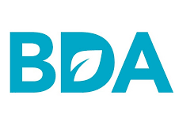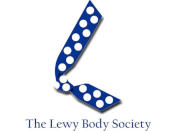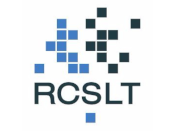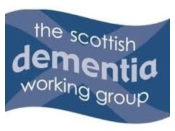
Living with dementia: food preparation
Living with dementia: food preparation
This factsheet is available for sponsorship, email marketing@dlf.org.uk
Sponsorship has no influence on our impartial content
Factsheet contents
- Introduction
- Managing food sell-by dates
- Using the cooker
- Kettles
- The fridge
- Microwaves
- Plugs and sockets
- Toasters
- Using the sink
- Utensils
- Storage
- Memory aids
- Assessing your needs
- Provision of equipment
- Funding sources for care
- For further advice from us
- Contributors
- Useful organisations and resources
- References and further reading
Introduction
It is important to remain involved in activities like food preparation - not only is it an opportunity for you to use existing skills, habits and routines, but continuing to cook has been found to be very beneficial for people with dementia (Claire, L, 2002). Research has shown that people with dementia who continue to use their skills with dementia have higher rates of self-confidence as they feel that they are ‘of use’ (Droes 2006).
Food preparation requires carrying out many complex multi-step tasks and some of these may be difficult for you. However, it is possible to adapt and learn new skills to help overcome these problems. The emphasis should be on simplifying tasks, completing tasks correctly first time and ensuring tasks require as few steps as possible. Safety is also an important consideration and should be borne in mind when carrying out all food preparation tasks.
Making some adaptations in the way you prepare food can help in your aim to be as independent as possible, for as long as possible. These changes can involve altering the kitchen environment and using equipment or telecare that considers your needs as a person living dementia.
Every person with dementia is an individual and it is important to bear this in mind when deciding what will suit you best.
Managing food sell-by dates
For some people with dementia, it can be tricky to keep track of food sell-by dates. If this is a problem for you here are a number of strategies you can employ which can help to manage this issue.
A simple approach could be switching to a smaller fridge freezer. There are both standard and counter top small fridge freezers on the market. A smaller model can simplify things as it could help you to see what food is in the fridge and/or freezer more clearly. A counter top model may be suitable for people who have difficulty bending. Also labelling stored food with prominently positioned stickers can help you to see and keep track of sell-by dates.
At the early stages of dementia, a fridge magnet organiser fastened to the front of the fridge can help with keeping track of sell-by dates. Here you can write reminders to yourself, e.g. 'cheese must be eaten by 29 August'. It could be used in conjunction with a calendar or talking clock with reminders.The same procedure can also be applied to perishable items in you cupboard.
In addition to fridge magnets, you could enlist the help of your carer or family to place signage on cupboards indicating what foods are kept within, helping you to remember what you have in store.
As dementia progresses some people may find that reminders and/or calendars no longer work. Instead you could designate a specific food clear out day where you and your carer go through your cupboards and fridge freezer checking for out-of-date food.
Using the cooker
Gas cookers and hobs
- If you have had your gas cooker for some time it may need to be lit manually. When this is the case it is essential to use a safety gas lighter rather than matches
- When the gas is lit automatically, a control dial is turned on at an angle and the burners are ignited. This is more convenient and safer than a separate ignition button as it only requires one action to operate
- Many modern gas cookers are now fitted with a flame supervision device. This means the supply of gas will shut off if the burner does not ignite or is blown out.
Electric cookers and hobs
- Cookers and hobs are operated with either a dial or digital controls
- Dial controls are straight forward to operate and are more intuitive in their use, however they may be difficult for you to turn
- Digital controls can be more problematic to operate as they require the buttons to be pressed several times to reach the correct setting. This may also be difficult for you if you are less dexterous than before
- Also the buttons tend to be the same colour as the surrounding background and therefore be difficult to see
- The selected setting is shown as a number on some models and whether you can read this depends on your eyesight.
Both gas and electric cookers and hobs require several procedures to ensure they are used safely. You might wish to consider using other appliances such as the microwave. However, if you have been using your cooker or hob for many years you may wish to continue to use this. Several pieces of equipment are available to help ensure your safety.
Stove alarm/guard
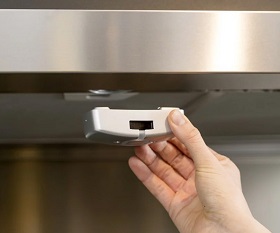 A frequent symptom of dementia is forgetfulness - this can potentially be a problem when working with cookers and the possible risk of fire.
A frequent symptom of dementia is forgetfulness - this can potentially be a problem when working with cookers and the possible risk of fire.
A stove alarm is fitted with magnets and so can be placed on cooker hood, or onto the wall or cooker panel with screws. In the circumstances when you leave the cooker unattended, and heat builds up, the alarm sounds. You can then return to the kitchen, if it is safe to do so, to switch off the cooker.
The alarm is dependent on you being able to hear it and to take the appropriate action. Should you not be able to manage either of these, other solutions will need to be considered.
Cooker isolator
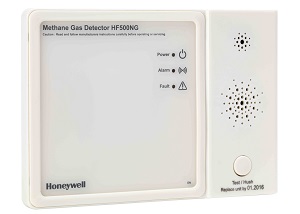 It may have been decided that it is no longer safe for you to use the cooker on your own. However it may be necessary for other people to use the cooker, or for you to use the cooker with their assistance. In these circumstances you may wish to consider installing a cooker isolator. This is part of a telecare system and will need to be fitted by the telecare engineer.
It may have been decided that it is no longer safe for you to use the cooker on your own. However it may be necessary for other people to use the cooker, or for you to use the cooker with their assistance. In these circumstances you may wish to consider installing a cooker isolator. This is part of a telecare system and will need to be fitted by the telecare engineer.
A PIN pad is fitted on to the wall, the PIN needs to be entered to switch the cooker on and off. In addition, a natural gas detector or a heat detector is placed in the kitchen. When the gas detector or heat detector is activated, the cooker is switched off automatically and the telecare system operates. In addition to the gas and heat detectors, a smoke detector is placed in an adjacent room.
Further reading: Information relating to smoke and heat alarms, extreme temperature sensors, gas detectors and carbon monoxide monitors can be found in DLF's fact sheet Living with dementia: home safety and security.
Coloured raised dots
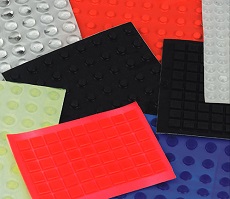 If you find it difficult to select the correct ring or burner or inadvertently turn on more rings or burners than you require, then placing different coloured raised dots on each dial can help in your selection.
If you find it difficult to select the correct ring or burner or inadvertently turn on more rings or burners than you require, then placing different coloured raised dots on each dial can help in your selection.
It is advisable to use the rings at the front of the cooker rather that leaning over to reach the rings at the back.
Stove stickers
Over time the numbers and symbols around the cooker dials can become worn and difficult to see. In addition, you may not be able to recall which dial turns on which ring or burner and this can cause confusion. Stove stickers can be positioned to replace the worn-out numbers and symbols. This can make it simpler for you to select the correct ring or burner and therefore improve safety.
Contour knob turner
 Cooker dials may be stiff to turn if your grip is weak. A contour knob turner has numerous adaptable pins which retract and grip onto the cooker dial. This holds the dial securely and helps provide leverage to turn the cooker dial.
Cooker dials may be stiff to turn if your grip is weak. A contour knob turner has numerous adaptable pins which retract and grip onto the cooker dial. This holds the dial securely and helps provide leverage to turn the cooker dial.
Kettles
Electric jug kettle
- It can be helpful to know at a glance if a kettle is on or off. An illumination in the switch is useful - the brightness can attract your attention
- The switch of the kettle should contrast with the colour of the jug of the kettle, making it simpler for you to see
- A clear window in the kettle to make it possible to see how much water the kettle contains
- The kettle should also have a boil dry function so that it turns itself off automatically when it does not contain enough water - this is helpful in case you forget that you have put the kettle on.
Glass electric kettle
- These kettles are transparent and make it possible for you to see at a glance how much water is in the kettle
- The jug lights up when the kettle is boiling and changes colour when this is complete. It is then clear to see if the kettle is off or on.
- The kettle should also have a boil dry function so that it turns itself off automatically when it does not contain enough water - this is relevant if you become distracted and forget you have put the kettle on.
Ideally the kettle should be cordless and have a round base so that it is always possible to place it correctly. The handle should be comfortable to hold and have a wide gap for you to pass your hand through. This is particularly important if your grip and coordination is not a good as it once was.
Lightweight mini travel electric kettle
 This is smaller in size but has the same familiar design as a standard electric kettle, it is therefore lighter and easier to lift. Not all lightweight mini kettles have the same features as standard electric kettles and this should be considered when deciding which model is most suitable for you.
This is smaller in size but has the same familiar design as a standard electric kettle, it is therefore lighter and easier to lift. Not all lightweight mini kettles have the same features as standard electric kettles and this should be considered when deciding which model is most suitable for you.
Cooker hob whistling kettle
If you prefer to use a kettle that is placed on your cooker top, a whistling kettle can alert you when the water has boiled. This is important as you may have become distracted and not recall that you have put the kettle on to boil. Cooker hob kettles do not have the same safety features as electric kettles and overall it is preferable to use an electric kettle.
Hot water dispenser
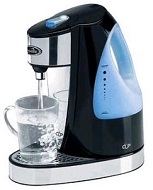 If you find lifting a kettle of any size difficult it may be appropriate to consider a hot water dispenser. These have the advantage of dispensing hot water at the press of a button. The amount of water depends on the model. The reservoir also needs to be filled, you could perhaps use a plastic jug to manage this or ask somebody else to help you.
If you find lifting a kettle of any size difficult it may be appropriate to consider a hot water dispenser. These have the advantage of dispensing hot water at the press of a button. The amount of water depends on the model. The reservoir also needs to be filled, you could perhaps use a plastic jug to manage this or ask somebody else to help you.
Pump action flask
You may wish to have a hot drink where it is not possible to plug in a kettle. A pump action flask could solve this problem. It does not need to be lifted to dispense the water, but does need to be filled with boiling water. You could perhaps manage this yourself, but it more likely somebody else would need to help you.
The fridge
Labels
Fridges can be freestanding, integrated or part of a fridge freezer unit. In all instances it may be useful to label the fridge to help identify its location. This is particularly important when the fridge is integrated behind a unit door and cannot be seen. Also it is helpful that the fridge and freezer sections are labelled separately, this helps ensure that you store food in the correct part of the fridge freezer. To be seen most clearly opt for labels that contrast with the colour of the fridge and contain a word, picture or both. Labels can be pre-made or created at home.
Counter top fridge
Some people with dementia may have difficulty using below the counter fridges. This can be because they have difficulty bending down to the fridge or they may not look below eye level. When this applies to you it may be worth considering a counter top fridge.
Glass fronted fridge
Glass fronted fridges and fridge freezers are available in the same styles as standard appliances. They enable you to see at a glance what is stored in the fridge. This may be an advantage for you as seeing the food may act as a prompt to eat.
Handles
Many freestanding fridges have integrated handles, either at the top or side of the fridge. These may be problematic to use as the handle can be difficult to see and pull. Suction or magnetic external handles can be placed on the outside of the fridge making it simpler for you to open the door.
Fridge alarm
It is easy to become distracted and not shut the fridge door correctly. A fridge alarm is fitted with self-adhesive pads to the door of the fridge and sounds an audible alarm if the fridge door is left open. This will prompt you to return to the fridge to shut the door correctly. The loudness of the alarm depends on the model, so you will need to ensure you can hear the alarm, identify where it is coming from and act accordingly.
Microwaves
Preparing food in a microwave is a quick and efficient way to cook ready-made or frozen meals and as a result you may find you that you are increasingly reliant on it. Microwave ovens have some useful safety features: only small amounts of water are needed for cooking, they cook for a pre-selected period of time and containers designed for use in the microwave should not get as hot as those in an oven.
Manual microwave
- Manual microwaves have two dials, one to control the time and the other to control the power. They are set by turning a dial
- Manual microwaves have a time limiter, an additional safety feature that is useful if you set the microwave to cook too long by mistake.
Digital microwave
- Digital microwaves require buttons to be pressed in the correct sequence to set them. There is therefore more room for error and confusion. It may also be more difficult for you to see the digital display to know if the correct setting has been selected. However, many microwaves have pre-programmed settings which can be selected by pressing only a couple of buttons. This could be an advantage for you if you tend to use the microwave repeatedly for the same purpose
- It is possible to set digital microwaves for longer times than a manual microwave. This may be a safety consideration if you set it to operate for too long
Manual and digital microwaves can either have a pull handle or a door that is released when a button is pressed. The pull handle is more intuitive to use and the colour should contrast with the body of the microwave. The button should be in a contrast colour to the body of the microwave and be large and easy to press. To be simple to operate, dials should contrast with the colour of the microwave and the numbers should be clear for you to see.
Talking microwave
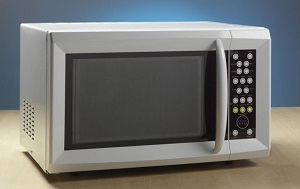 A talking microwave speaks the settings and operations as the buttons are pressed. It is therefore possible immediately to ensure the correct setting has been selected. This may be an advantage to you if it is difficult for you to see the controls on a manual or digital microwave.
A talking microwave speaks the settings and operations as the buttons are pressed. It is therefore possible immediately to ensure the correct setting has been selected. This may be an advantage to you if it is difficult for you to see the controls on a manual or digital microwave.
Coloured raised dots
These can be helpful when setting the manual microwave to the correct number of minutes. A raised dot is placed on the dial and another corresponding coloured dot is placed on the control panel. When you turn the dial and the two dots meet the correct time has been selected and the microwave can be switched on. On a digital microwave the dots could be placed on the buttons to help ensure you select the correct programme.
Plugs and sockets
Plug cover
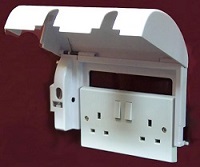 When you are being safety conscious and pulling out plugs it is possible to pull out ones which need to remain plugged in. A lockable plug cover shuts over single or double sockets and ensures it is not possible for the plugs to be removed. The cover requires the key to open it.
When you are being safety conscious and pulling out plugs it is possible to pull out ones which need to remain plugged in. A lockable plug cover shuts over single or double sockets and ensures it is not possible for the plugs to be removed. The cover requires the key to open it.
Plug pull handles
 Plugs can be difficult to grip and pull out of sockets. When you are finding this is the case, fitting pull handles on the plugs may help. The handles are either looped on or stuck to the plug and make removing plugs from sockets less of a problem. A label can be stuck to the handle to help identify the appliance the plug is linked to.
Plugs can be difficult to grip and pull out of sockets. When you are finding this is the case, fitting pull handles on the plugs may help. The handles are either looped on or stuck to the plug and make removing plugs from sockets less of a problem. A label can be stuck to the handle to help identify the appliance the plug is linked to.
Socket plates
When the socket plate is the same colour as the background wall, it may be difficult for you to see it. Socket plates are available in different colours and it may be helpful to fit one which contrasts with the background wall.
Toasters
Ideally the toaster should be colourful and draw attention to the eye. Transparent or glass toasters enable you to see the bread as it toasts. If you find you are not as strong as you once were, the lever should be light to push down. Also, it is helpful if the lever contrasts with the colour of the body of the toaster as this makes it clearer to see. As an additional safety feature consider a toaster that ejects the toast automatically (an auto shut off) rather that one fitted with a manual eject lever.
Using the sink
Tap turners
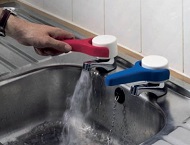 Kitchen sink taps come in a variety of styles and might be difficult to turn if your grip is not as strong as it was. It may also be a problem distinguishing between the hot and the cold tap. Tap turners can be helpful as they are fitted on to the taps and operate as levers making the taps easier to turn on and off. They are also coloured red and blue which helps to identify the hot and the cold taps.
Kitchen sink taps come in a variety of styles and might be difficult to turn if your grip is not as strong as it was. It may also be a problem distinguishing between the hot and the cold tap. Tap turners can be helpful as they are fitted on to the taps and operate as levers making the taps easier to turn on and off. They are also coloured red and blue which helps to identify the hot and the cold taps.
Replacement taps
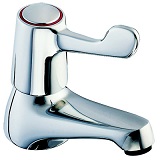 Rather than fit tap turners you may prefer to replace the taps with a style that is easier to manage. Lever taps might be suitable or perhaps cross style taps, whichever is more familiar.
Rather than fit tap turners you may prefer to replace the taps with a style that is easier to manage. Lever taps might be suitable or perhaps cross style taps, whichever is more familiar.
Flood detector
A flood detector is a small unit that is placed on the floor under the sink. It sends out an audible alarm when an unattended sink overflows and alerts you to return to the sink and turn the taps off. The loudness of the alarm varies, and you will have to be able to hear it, identify the source and respond appropriately. Flood detectors can work in your home when only you hear the alarm. Alternatively, it is possible to link them to a telecare system; there is additional information on telecare in DLF's fact sheets Living with dementia: home safety and security and Choosing telecare.
Sink overflow plug
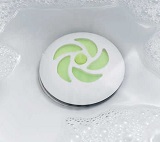 When working at the sink you may become distracted and leave the taps running. A sink overflow plug is placed in the sink plug. When the water reaches a certain level, the sink overflow plug opens and releases the water down the plughole thus preventing a flood. This water level is then maintained until you turn the taps off. The sink overflow plug also changes colour when the water is too hot.
When working at the sink you may become distracted and leave the taps running. A sink overflow plug is placed in the sink plug. When the water reaches a certain level, the sink overflow plug opens and releases the water down the plughole thus preventing a flood. This water level is then maintained until you turn the taps off. The sink overflow plug also changes colour when the water is too hot.
Utensils
Tin openers
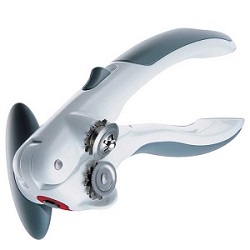 For many people with dementia using tinned food is economical and convenient, however opening tins may prove difficult.
For many people with dementia using tinned food is economical and convenient, however opening tins may prove difficult.
Whilst the method of using the tin opener is the same design features vary. Metal butterfly tin openers are straightforward to use and are likely to be familiar to you. Basic models have narrow metal handles with a small turning butterfly and these can be difficult to grip. Those with wide non-slip handles and a larger turning butterfly may be easier for you to hold and use.
Tin openers are available in several colours, making them clearer to identify in amongst other utensils.
Ring pull tin opener
Tins are often opened with a ring pull and whilst this stops the need for a tin opener the rings can be difficult to pull. A ring pull tin opener hooks on to the ring pull and helps you lever the tin lid open.
Bottle and jar opener
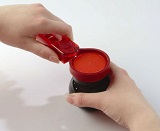 Bottles and jars can be difficult to open if your grip is weak. There are different types of bottle and jar openers available One type loops around lids and uses a lever action to assist with the removal of lids. Another type is a rubber cone that grips on top of the bottle - this involves less steps to use and so may be easier to operate. Bottle and jar openers may be suitable in the early stages of dementia, but they are more difficult to use in later on.
Bottles and jars can be difficult to open if your grip is weak. There are different types of bottle and jar openers available One type loops around lids and uses a lever action to assist with the removal of lids. Another type is a rubber cone that grips on top of the bottle - this involves less steps to use and so may be easier to operate. Bottle and jar openers may be suitable in the early stages of dementia, but they are more difficult to use in later on.
Traditional style utensils
You may find that whereas you previously could operate small electric appliances this has become more difficult. Traditional style utensils, such as a rotary whisk and box grater, can be straightforward and effective to use and can do most of the functions previously carried out by electric appliances. Many utensils are available with easy grip handles which can be of assistance if you are becoming less dexterous. Utensils are also available in several colours which can help making them clearer to identify in a drawer or against a work surface.
Angled knife
 Holding a knife to cut can be difficult if your grip is not as strong as it was. A knife with a handle angled at 90 degrees could be helpful as it limits the strain on your wrist and hand. The cutting action is the same as standard knife. NB - this type of knife may not be suitable for some people living with dementia - its style and purpose might not be easy to comprehend.
Holding a knife to cut can be difficult if your grip is not as strong as it was. A knife with a handle angled at 90 degrees could be helpful as it limits the strain on your wrist and hand. The cutting action is the same as standard knife. NB - this type of knife may not be suitable for some people living with dementia - its style and purpose might not be easy to comprehend.
Scissors
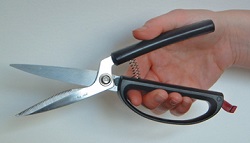 Spring-loaded scissors open automatically and are easy to use if you have a weak grip. Also, long handled scissors with a soft handle many be easier for you to hold and operate.
Spring-loaded scissors open automatically and are easy to use if you have a weak grip. Also, long handled scissors with a soft handle many be easier for you to hold and operate.
Pots and pans
Pots and pans are available in a number of colours - this may be helpful to provide colour contrast against the background. Also pans in different colours can help you select the correct size pan. Clear pots and pans, or clear lids, can help you see at a glance how the food you are cooking is progressing.
Silicone pan handles
You may find that your grip is not as strong as it once was, this can be a problem when lifting pots and pans. Silicone pan handles fit on the existing handles of pots and pans and come in a range of colours. They are textured, which can help you to hold them, and heat resistant. Fitting different coloured handles to your pot or pan handles could also help you select the correct one to use.
Chopping boards
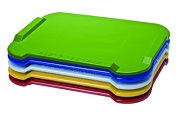 In general people with dementia benefit from colour and contrast. It may be helpful for you to use coloured chopping boards, so that when food is being prepared it contrasts with the chopping board.
In general people with dementia benefit from colour and contrast. It may be helpful for you to use coloured chopping boards, so that when food is being prepared it contrasts with the chopping board.
Trolleys
 If you need to transfer food from the kitchen to elsewhere in the house a household trolley can help. Trolleys of this type have two shelves and a frame which is pre-set or adjusted to suit your height. The trolley is designed so that it is placed it in front of you and pushed as you walk.
If you need to transfer food from the kitchen to elsewhere in the house a household trolley can help. Trolleys of this type have two shelves and a frame which is pre-set or adjusted to suit your height. The trolley is designed so that it is placed it in front of you and pushed as you walk.
Trolleys are not walking aids and an Occupational Therapist or Physiotherapist can assess if it is suitable for your needs.
Perching stools
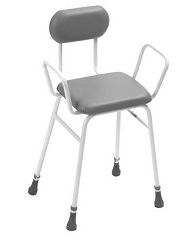 If you find that preparing food is tiring, especially if you are standing, a perching stool can be of benefit. The design and sloping angled seat enables it to be placed close to a sink or work surface. The perching stool can be height adjustable and have the addition of a back and arms if you require support to stand up from sitting.
If you find that preparing food is tiring, especially if you are standing, a perching stool can be of benefit. The design and sloping angled seat enables it to be placed close to a sink or work surface. The perching stool can be height adjustable and have the addition of a back and arms if you require support to stand up from sitting.
You should to be able to get on and off the perching stool - an Occupational Therapist or Physiotherapist will be required to assess if it is suitable for you..
Storage
If you have memory problems it can be difficult to recall what is stored in each kitchen cupboard. Removing the cupboard doors allows you to see the contents. Alternatively replacing the wooden doors with clear doors could be beneficial. Ideally, regularly used items should be placed at eye level (this can also help you to remember to use things near their sell-by-date). It can be beneficial to group similar items together, on open shelves at an accessible height, e.g. items required to make a drink or prepare a meal.
Labels
You may not wish to have the cupboard doors removed or replaced. In this instance it may be an advantage to label the cupboards to help identify the contents. Labels can be placed on the door and these should contrast with the colour of the cupboard. Labels may contain a word, picture or both. It might also be helpful to take a photograph of the contents of the cupboard and place this on the door. Whenever possible labels should be positioned at eye level.
Food storage
When food is stored in transparent containers it is possible to see the contents. It is advisable to label the containers to ensure there is no confusion between similar looking products. Glass jars with coloured screw or pop off lids can be simpler to use. Alternatively, plastic containers with push on and lift off lids can also be helpful.
Shelf riser
A shelf riser placed in a cupboard can help to ensure that all the items in the cupboard are visible when you open the doors.
Drawer organiser
Using a drawer organiser helps you to keep drawers tidy so that items can be located more easily.
Counter top storage
If you frequently find you misplace items it is helpful to tidy up and remove things you do not use. Rather than tidy away the necessary items, it can help to have them stored on the counter tops. Here they can be seen and selected without the need to look through cupboards and drawers. It can be beneficial to group items that are used together in the same place. Storage in open baskets or trays where items can be seen at a glance can work best.
Memory aids
Timers
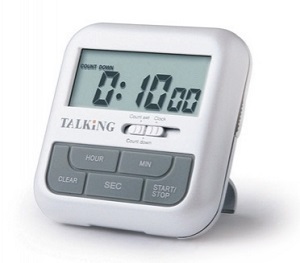 If you find you often lose track of time, a timer can be helpful as they can remind you when any food you are cooking is ready.
If you find you often lose track of time, a timer can be helpful as they can remind you when any food you are cooking is ready.
- A mechanical timer is similar to a clock and is wound round to set the minutes. An audible alarm rings when the time has passed. Timers are available with a cord so it is possible to take the timer with you and to be alerted immediately when the alarm sounds.
- A digital timer is set by pressing buttons and may be more difficult to operate. Digital timers are also available that speak the settings as you press the buttons. The alarm sounds when the time has passed alerting you to attend to a task. Digital timers are available with clips to attach to your clothing or can be small enough to fit in your pocket.
- Hourglass sand timers are simple to operate and are pre-set to measure differing numbers of minutes. They do not provide an alarm and rely on you to pay attention to them as the sand is running out.
- Some smart phones and tablets have timer features that can be useful
Prompting devices
Prompting devices are designed to display or play pre-recorded messages. A prompting device could be placed in the kitchen. When you walk into the detection beam it plays a recorded message. This message then provides a prompt to carry out actions, e.g. such as ensuring all the appliances are switched off. The message can be recorded either by yourself or family member or carer. You will need to decide whether this type of device meets your needs -- some people may be troubled by the voice and feel there is somebody in the house with them.
Clocks
Looking at the time on the clock can act as a prompt that it is time to prepare some food.
Calendar day wall clock
A calendar day wall clock tells the time and displays the day, date and year. These can be either analogue or digital.
Digital day clock with reminders and prompting devices
 Some digital day clocks can have functions in addition to telling the time. These can automatically display or play pre-recorded messages at preset times, e.g. to remind you to prepare a meal, or to use up particular food items which are due to go out of date.
Some digital day clocks can have functions in addition to telling the time. These can automatically display or play pre-recorded messages at preset times, e.g. to remind you to prepare a meal, or to use up particular food items which are due to go out of date.
These devices require setting up to use - it is likely a family member or carer would need to do this for you. Some digital day clocks and prompting devices can be operated remotely via an application on a smart phone.
Noticeboards
Noticeboards come in various styles and sizes - they can be large and fitted on to the wall or portable and carried around the home and placed as required. Whiteboards that can be written on with erasable marker pens are particularly helpful as they can be changed when necessary. It is important that you can see the colour of the pen against the background of the board. It may be necessary to try out different colours and nib sizes to find out what suits you best. To be most effective noticeboards should not become over crowded with information.
Assessing your needs
A range of conditions may cause forgetfulness, anxiety, low mood and confusion, however they may also be early signs of dementia. A visit to your GP would be recommended to rule out other causes and allow for a better understanding of the illness and how it may progress, as well as strategies on how to manage the symptoms.
The assessment for dementia is a process that takes time and goes through various stages and tests. These may include a physical examination, a blood test and interviewing both the person and their concerned friend/relative separately. This may lead to a referral to a local memory service or clinic. The GP, Community Psychiatric Nurse or a member of the memory clinic staff will be able to advise on symptoms, how the disease may develop and provide information on appropriate treatment. They will also be able to advise you on what support there is available locally. Prior to an appointment it can be useful to keep a journal or diary of any tasks that have become more difficult or concerns that you may have.
The GP can refer you for a Health and Social Care Needs Assessment, or you can contact your local authority Adult Social Care Department and make a self-referral, or have a friend or relative do it for you. By law anyone who appears to need care and support can request an assessment regardless of their income or savings.
The assessment will focus on your needs, how they impact on your well-being and on what you want to achieve and will aim to identify any difficulties you may have in caring for yourself. An Occupational Therapist will carry out the assessment and will be able to advise on strategies to help reduce any identified risks and recommend any equipment that may be helpful to maintain independence. If someone else is helping you they are also entitled to a carers assessment, which will help to identify what help and support they may need.
There are a number of charitable organisations listed below that can provide help and support for the person with dementia and their relatives and carers.
Provision of equipment
Many simple assistive technology devices mentioned in this fact sheet can be privately purchased. Others can be provided by local authorities or the NHS to meet an assessed need; you or a family member can request a home assessment from an occupational therapist
Permanent loan: Local Authority and health provision
If you require disability equipment, telecare or adaptations to your home then your local authority may be able to help. They can supply equipment or minor adaptations that cost under £1,000, free of charge. (Department of Health 2014, section 2.9). In Scotland, Local Authorities make their own arrangements for provision of minor adaptations and details can be accessed via your Council's website.
Some equipment such as pressure relieving cushions, mattresses, some mobility aids and wheelchairs are supplied by your local Health Authority. A referral to the District Nurse or Wheelchair Service for these items can be made via your GP or other health professionals including a Community Occupational Therapist or Physiotherapist.
Disabled Facilities Grant (DFG)
Should you need adaptations to your home that cost more than £1,000 that will allow you to continue to live there, you may be eligible for a Disabled Facilities Grant (DFG). An Occupational Therapist will complete an assessment and if the work is deemed necessary to meet your needs and is reasonable and practical, then they will arrange for a financial assessment to be undertaken.
If you meet the criteria for funding, the Occupational Therapist will make recommendations for the adaptations required.
Private purchase
If you do not wish to use local authority services, there are independent Occupational Therapists who can assess your needs and help to advise or assist you in buying any equipment or arrange adaptations to your home that you may require.
You can also purchase equipment privately, but it is recommended that you compare different options first. There may be an equipment demonstration centre near you where you can look at and try out equipment before purchasing, as well as receiving impartial advice.
Charity and Grant funding
Charitable trusts may sometimes provide equipment or give a grant for equipment purchase.
Turn2Us is a national charity that helps people who are in financial difficulty find grants for the provision of equipment, and Community Care gives a list of charitable organisations that give grants.
Charities tend to give awards in accordance with a predetermined criterion, so it is important that you carefully select the organisations that apply to your condition. There are also some workplace charities that will provide support for ex-employees. If you are or have served in the Armed Forces, or are a dependent or carer of a person who has served, The Royal British Legion may be able to provide you with support for specialist dementia care or grants for equipment and adaptations to your home, or small crisis grants to meet unexpected expenses.
Funding sources for care
If you need support with daily tasks that may include help from a carer, the delivery of meals or residential care then your local authority may help with the cost. How much support you are entitled to will depend on your income and savings and what your care needs are. A financial assessment of your means will be carried out to establish how much support you are entitled to.
You may be eligible for further financial support such as Attendance Allowance or Personal Independence Payment (PIP) and if you have a person who cares for you for 20 hours or more a week, they may be eligible for some financial support.
If you live alone you can apply to your local authority for a 25% reduction on your Council Tax bill, or if you live with someone else then they may be eligible for a 25% reduction on the Council Tax bill. As your condition progresses, they may be eligible for a further 25% reduction.
Private carers and residential care
If you are looking for a carer or are considering residential care, then you should ensure that the staff are trained in dementia care and are able to give the specialist help you need. A residential home should be designed to provide the best possible environment for you. There are a number of organisations that can help you with choosing a suitable home, including:
- Elderly Accommodation Council
- Housing Care.org
- DementiaUK
- Relatives and Residents Association
- Paying for Care
Care Home ratings/selector
Inspection reports and care home ratings can be found via:
- England – Care Quality Commission
- Scotland – Care Inspectorate
- Wales – Care Inspectorate Wales
- Northern Ireland – Regulation and Quality Improvement Authority
Charity and Grant funding
Charitable trusts may sometimes provide funding for care, nursing or residential respite, permanent care or a befriending service. Charities tend to give awards in accordance with a predetermined criterion, so it is important that you carefully select the organisations that apply to your condition. There are also some workplace charities that will provide support for ex-employees. If you are or have served in the Armed Forces, or are a dependent or carer of a person who has served, The Royal British Legion may be able to provide you with support for specialist dementia care or small crisis grants to meet unexpected expenses.
Further information relating to grants is available from:
- Community Care – a list of charities providing grants.
- Turn2us - Turn2us is a national charity that helps people in financial hardship gain access to welfare benefits, charitable grants and support services.
- Housing grants information from Disability Rights UK - led by people with diverse experiences of disability and health conditions, from different communities.
- Disability Grants - grants for disabled adults.
- My grants - accessibility grants for disabled and older people.
- Grants for individuals - this website is run by the Directory of Social Change and lets subscribers search for grants. It is intended for organisations searching for funding on behalf of individuals.
- The Money Advice Service - Charitable grants and major and minor adaptations.
VAT relief
If you have a diagnosed long-term condition, you may be able to claim VAT relief on purchases relating to the condition. The company supplying the equipment should be able to advise you, or there is general information on VAT relief on the GOV.UK website.
For further advice from us
For clear, practical advice and information on products and suppliers of daily living equipment, please have a look at our Living made easy website.
If you would like further advice related to choosing equipment for everyday living you could try relevant sections of AskSARA, our free online guided advice tool. AskSARA will ask you questions about yourself and your environment and then offer relevant advice, product suggestions and supplier details.
You can contact the DLF Helpline, which is open Monday to Friday from 10am to 4pm. Tel: 0300 999 0004 (calls charged at your standard land line rate even if you are phoning from a mobile).
Alternatively, you may wish to contact us via email: info@dlf.org.uk or by letter: DLF, 34 Chatfield Road, Wandsworth, London SW11 3SE.
To help us give you a concise and informative reply, please provide us with as much detail as possible, including information on the difficulties you are having and any solutions you have considered, such as equipment ideas.
Another source of advice is a disabled or independent living centre where you would have the opportunity to try out a range of equipment. There are several of these around the country where you can go for impartial advice. Your local authority will also be able to give you details of centres in your area.
Contributors
Janet Corbett
 Janet Corbett is an occupational therapist with many years’ experience in supporting people with dementia along with their families and friends. janet has a particular interest in helping people to develop techniques to compensate for memory impairment. She also holds dementia friendly exercise classes for older people in the local community. Janet has a BSc in Occupational Therapy from Queen Margaret University and an MSc in Dementia Studies from the University of Stirling.
Janet Corbett is an occupational therapist with many years’ experience in supporting people with dementia along with their families and friends. janet has a particular interest in helping people to develop techniques to compensate for memory impairment. She also holds dementia friendly exercise classes for older people in the local community. Janet has a BSc in Occupational Therapy from Queen Margaret University and an MSc in Dementia Studies from the University of Stirling.
Roisin Hodgson
 Roisin Hodgson qualified as an occupational therapist in 1993 and has worked extensively in hospitals and within the community. Now working as a private occupational therapist, Roisin has an interest in occupational therapy approaches to anxiety, panic and post traumatic stress disorder. Many of Roisin's clients have dementia; she works with them and their families advising on a range of solutions to help maintain independence, including home adaptations, daily living aids and telecare.
Roisin Hodgson qualified as an occupational therapist in 1993 and has worked extensively in hospitals and within the community. Now working as a private occupational therapist, Roisin has an interest in occupational therapy approaches to anxiety, panic and post traumatic stress disorder. Many of Roisin's clients have dementia; she works with them and their families advising on a range of solutions to help maintain independence, including home adaptations, daily living aids and telecare.
Nina Evans
 Nina Evans works alongside the design team at Designability. Working in partnership with users, carers and professionals, Nina carries out clinical trials with end-users, developing and promoting assistive technology to improve quality of life. Nina's qualifications include a Diploma of the College of Occupational Therapists and an MSc in Clinical Research.
Nina Evans works alongside the design team at Designability. Working in partnership with users, carers and professionals, Nina carries out clinical trials with end-users, developing and promoting assistive technology to improve quality of life. Nina's qualifications include a Diploma of the College of Occupational Therapists and an MSc in Clinical Research.
Useful organisations and resources
Age UK Advice is a free, confidential, national phone service for older people, their families, friends, carers and professionals. Their team of experts can provide advice and information on a number of topics including benefits, concerns about hospital stays, advice choosing care homes etc. The website can signpost you to local services including home helps, foot care, handy person services and dementia support.
The Age UK network includes Age Scotland, Age Cymru and Age NI.
Alzheimer's Society's website provides advice and support regarding all aspects of dementia – including the different types of dementia, symptoms, diagnosis and treatments available. They also run Dementia Connect, a comprehensive services directory for people affected by dementia - areas cover England, Wales and Northern Ireland.
.
Website: www.alzscot.org
24 hour Dementia Helpline: 0808 808 3000
Alzheimer Scotland provides a wide range of specialist services for people with dementia and their carers. They offer personalised support services, community activities, information and advice at every stage of the dementia journey.
Disabled Living
Burrows House, 10 Priestley Road
Wardley Industrial Estate, Worsley
Manchester, M28 2LY
Website: www.bbuk.org.uk
Telephone: 0161 607 8219
Email: bbuk@disabledliving.co.uk
Bowel and Bladder UK's National Confidential Helpline is managed by a team of Specialist Nurses and Continence Product information staff, who can be contacted for advice on specialist services, product information and general advice to help treat or manage bladder and bowel problems that may occur as a symptom of Dementia. Opening hours Monday to Friday 9am–4.30pm.
5th Floor, Charles House
148/9 Great Charles Street Queensway
Birmingham, B3 3HT
Website: www.bda.uk.com
Telephone: 0121 200 8080
The BDA is the only body in the UK representing the whole of the dietetic workforce. It is a trade union and professional body representing the professional, educational, public and workplace interests of its members.
Head Office
20 Great Dover Street
London SE1 4LX
Website: www.carersuk.org
Telephone: 020 7378 4999
Carers UK provide advice and support for all carers, whether they are new to looking after someone or have been a carer for a long time. Their telephone advice and support service is available if you wish to talk to someone about caring, with further information and advice available on the website. The website also provides contact details for Carers Wales, Scotland and Northern Ireland.
Carewatch Care Services Ltd
Libra House, Sunrise Parkway
Linford Wood
Milton Keynes MK14 6PH
Website: www.carewatch.co.uk
Telephone: 01908 557 950
Carewatch provide home care services throughout the UK, designed to enable people to remain as independent as possible within their own home. They offer multiple services including home visits, personal care, practical help, live-in care and dementia care at home and long term home care.
Dementia Friends provides information, support and learning for those who have a relative or know someone with dementia. Anyone of any age can be a dementia friend. Visit their website for more details.
Second Floor
356 Holloway Road
London N7 6PA
Website: www.dementiauk.org
Telephone: 020 7697 4160
Support line: 0800 888 6678
Dementia UK provide specialist dementia support for families through their Admiral Nurse service. The Admiral Nurses work with families giving one-to-one support, expert guidance and practical solutions.
Unity House
Westwood Park
Wigan, WN3 4HE
Website: www.lewybody.org
Telephone: 01942 914000
Support line: 0800 888 6678
Email: info@lewybody.org
The Lewy Body Society funds research into Dementia with Lewy Bodies (DLB). It's mission is to raise awareness of DLB among the general public and those in the medical profession and decision making positions, They also provide information resources for patients and carers.
Website: www.nhs.uk
NHS Choices provides comprehensive information on the help and support available for people living with dementia. Other NHS websites include: NHS Inform (Scotland), Health and Social Care online (N.I.) and NHS Direct Wales.
Website: www.nhs.uk
The Patient Advice and Liaison Service from the NHS offers confidential advice, support and information on health-related matters. They provide a point of contact for patients, their families and their carers when using NHS services. Your local PALS service can be located using the search facility on their website.
Website: www.nice.org.uk
NICE provides national guidance and advice to improve health and social care.
The RICE Centre
Royal United Hospital
Combe Park
Bath, BA1 3NG
Website: www.rice.org.uk
Telephone: 01225 476420
Email: info@rice.org.uk
RICE is a registered charity committed to undertaking and publishing effective research aimed at improving the diagnosis, assessment and treatment of people with Alzheimer’s disease and other forms of dementia. The charity also offers several healthcare services for people living with dementia including a memory clinic.
106-114 Borough High Street
Southwark
London SE1 1LB
Website: www.rcot.co.uk
Telephone: 020 7357 6480
Email: reception@rcot.co.uk
The Royal College of Occupational Therapists is the professional membership body for occupational therapy staff in the UK. Their website includes information on how to find an independent occupational therapist through their online directory.
2 White Hart Yard
London SE1 1NX
Website: www.rcslt.org
Telephone: 020 7378 1200
The RCSLT is the professional body for speech and language therapists in the UK providing leadership and setting professional standards.
81 Oxford Street
Glasgow, G5 9EP
Website: www.sdwg.org.uk
Telephone: 0141 410 1171
Email: sdwg@alzscot.org
Funded by Alzheimer Scotland and the Scottish Government SDWG is an independent group run by people with dementia, their families and carers, which campaigns on behalf of, and provides a voice for, people living with dementia in Scotland.
Watson House
54 Baker Street
London W1U 7EX
Website: www.scie.org.uk
Telephone: 020 7766 7400
Email: info@scie.org.uk
The Social Care Institute for Excellence (SCIE) improves the lives of people who use care services by sharing knowledge about what works. It is a leading improvement support agency and an independent charity working with adults’, families’ and children's care and support services across the UK. The website contains a library of resources and services on wide range of topics, including dementia.
SFE Administrator
Studio 209, Mill Studio Business Centre
Crane Mead
Ware
Hertfordshire, SG12 9PY
Website: www.sfe.legal
Telephone: 0844 567 6173
Email: sfe@standagency.com
Solicitors for the Elderly provide a service to help you locate a local solicitor, near you, to help you with wills, power of attorney, trusts, probate, paying for care and other legal needs. They are a national organisation across the UK and the Republic of Ireland
Wimslow House
Water Lane
Grove Way
Wimslow, SK9 5AG
Website: www.tsa-voice.org.uk
Telephone: 01625 520320
Email: admin@TSA-Voice.org.uk
The website has information on the telecare industry and the services it provides to individuals. The TSA aims to promote and support the telecare industry and highlight the benefits of telecare for service users, their friends, family and carers.
Released January 2019, to be reviewed by January 2022, Version 1
References and further reading Show references
Alzheimer's Society (no date) Meal preparation and living alone, Available at: https://www.alzheimers.org.uk/get-support/daily-living/eating-living-alone (Accessed: 24th June 2018).
British Dietetic Association (no date) Dietitian Key Facts Dementia, Available at: https://www.bda.uk.com/improvinghealth/healthprofessionals/keyfacts/dementia_kf_sheet (Accessed: 24th June 2018).
College of Occupational Therapists (no date) Occupational Therapy Evidence Fact sheet Occupational Therapists help those with dementia and their carers. Available at: https://www.rcot.co.uk/file/662/download?token=b9B40zkz (Accessed: 24th June 2018).
Dementia Services Development Centre (no date) Kitchens. Available at: http://dementia.stir.ac.uk/design/good-practice-guidelines/kitchens (Accessed: 24th June 2018).
Royal College of Speech and Language Therapists (no date) Speech and language therapy works for people with dementia. Available at: https://www.rcslt.org/members/publications/publications2/dementia_leaflet_october_14 (Accessed: 24th June 2018).
National Institute for Health and Care Excelllence (2018) Dementia: assessment, management and support for people living with dementia and their carers. Available at: https://www.nice.org.uk/guidance/ng97 (Accessed: 24th June 2018).
NHS Quality Improvement Scotland () Scottish Intercollegiate Guidelines Network - Management of patients with dementia. Available at: http://umh1946.edu.umh.es/wp-content/uploads/sites/172/2015/04/Management-of-patients-with-dementia-NHS.pdf (Accessed: 24th June 2018).
Andersen, C.K., Wittrup-Jensen, K., Lolk, A., Andersen, K. & Kragh-Sørensen, P. (2004) Ability to perform activities of daily living is the main factor affecting quality of life in patients with dementia, Health And Quality Of Life Outcomes, vol. 2, pp. 52-52.
Barnes, S., Wasielewska, A., Raiswell, C. & Drummond, B. (2013) Exploring the mealtime experience in residential care settings for older people: An observational study, Health & Social Care in the Community, vol. 21, no. 4, pp. 442-450.
Crowe, J. & Gabriel, L. (2013) Errorless Learning and Spaced Retrieval Training for Clients with Alzheimer's Dementia, Physical & Occupational Therapy in Geriatrics, vol. 31, no. 3, pp. 254-267.
Frazer, S., M., Oyebode, J., R. & Cleary, A. (2012) How older women who live alone with dementia make sense of their experiences: An interpretative phenomenological analysis, Dementia (14713012), vol. 11, no. 5, pp. 677-693.
Hedman, A., Nygård, L., Almkvist, O. & Kottorp, A. (2015) Amount and type of everyday technology use over time in older adults with cognitive impairment, Scandinavian Journal of Occupational Therapy, vol. 22, no. 3, pp. 196-206.
Johansson, L., Christensson, L. & Sidenvall, B. (2011) Managing mealtime tasks: told by persons with dementia, Journal of Clinical Nursing, vol. 20, no. 17-18, pp. 2552-2562.
ÖÖhman, A., Nygåård, L. & Kottorp, A. (2011) Occupational performance and awareness of disability in mild cognitive impairment or dementia, Scandinavian Journal of Occupational Therapy, vol. 18, no. 2, pp. 133-142.
Rosenberg, L., Kottorp, A., Winblad, B. & Nygård, L. (2009) Perceived difficulty in everyday technology use among older adults with or without cognitive deficits, Scandinavian Journal of Occupational Therapy, vol. 16, no. 4, pp. 216-226.
Starkhammar, S. & Nygård, L. (2008) Using a timer device for the stove: experiences of older adults with memory impairment or dementia and their families, Technology & Disability, vol. 20, no. 3.
AskSARA
If you would like further advice regarding daily living equipment related to choosing equipment for everyday living you could try relevant sections of AskSARA. AskSARA is our free online guided advice tool. AskSARA will ask you questions about yourself and your environment and then offer relevant advice, product suggestions and supplier details.
| Attachment | Size |
|---|---|
| 15.11 KB | |
| 29.53 KB | |
| 19.03 KB | |
| 11.8 KB | |
| 16.29 KB | |
| 7.64 KB | |
| 14.54 KB | |
| 7.52 KB | |
| 11.96 KB | |
| 9.74 KB | |
| 6.9 KB | |
| 10.12 KB | |
| 13.25 KB | |
| 7.87 KB | |
| 15.2 KB | |
| 27.25 KB | |
| 7.23 KB | |
| 5.83 KB | |
| 15.37 KB | |
| 13.48 KB | |
| 17.54 KB | |
| 14.57 KB | |
| 11.09 KB | |
| 681.93 KB |
All rights reserved. No reproduction or transmission of this publication may be made without written permission. Inclusion (including any sponsorship) does not indicate endorsement or that any item has been recommended or tested. All information is provided without legal responsibility.
Disabled Living Foundation, Tel: 020 7289 6111, Fax: 020 7266 2922, Helpline: 0300 999 0004 10.00am-4.00pm, Email: helpline@dlf.org.uk, Website: www.dlf.org.uk
Reg. Charity No: 290069, VAT Reg. No: 226 9253 54
 (Tell me about the standard)
(Tell me about the standard)

Your personal information is required in order to claim Gift Aid. This information is kept by DLF/Shaw Trust for financial audit purposes. For more information on our privacy policy visit: https://www.dlf.org.uk/content/privacy-policy





